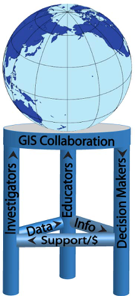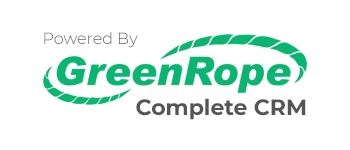Active Roster
Media
Sponsors
ORGANIZATIONAL HISTORY
In the 1980’s, Seth Brown, then president of the National Coalition for Marine Conservation-Pacific Region, asked then Executive Director Carl Nettleton the following question: why don’t research organizations work more closely together to better understand ocean issues?
In September 2006, following nearly 18 months of intensive research and more than 20 years of practice in ocean policy, politics, and conflict resolution, Carl attempted to answer the question in a presentation at the California and the World Oceans Conference in Long Beach, California.

The presentation focused on the potential to elevate research, public education, and public policy decisions to a new level using geographical information systems (GIS) as a collaborative tool. Called “A Collaborative Three-Legged Stool to Balance Ocean Investigations, Public Understanding, and Policy Decisions,” the presentation utilized the image on the left to show that if data could shared in such away that educators could provide clear information to the public and decision makers, then support could be found for the addition research that would be needed. The image imagined that GIS collaboration would link the thee legs of the stool.
The presentation was based, in part, on experience Carl had gained in San Diego during a six-year period starting in 1999 when he created and led a collaboration designed to coordinate a massive construction effort in that City’s downtown, even while numerous special events were held and daily life went on for residents, businesses and visitors. He led a team that guided the diverse interests of that community into a working unit that solved problems together.
This experience convinced him that a long-standing problem blocking collaboration and funding for ocean research and education could also be overcome by a people-based effort united by GIS technology.
Response to the Concept. The initial response to OpenOceans Global concept was rewarding. From the heads of government agencies to GIS practitioners the answer was: “this is needed, it would be great if you could create OpenOceans Global.”
Incorporation. So the real work began. OpenOceans Global was incorporated in the State of California on November 8, 2007 and obtained its 501(c)(3) status on April 17, 2009.
Local Funding. A founding board of directors was convened, and a prominent panel of advisors was assembled. The thinking was that initial funding could come from San Diego sources and starting with a local group of prominent directors would accomplish that initial goal. Unfortunately, that was not the case. It became clear that philanthropic funding would not be generated locally. Local funds were almost exclusively dedicated to hands-on projects in youth education or environmental restoration.
SEMPRA Grant 2009. There was an exception, in 2009, OpenOceans Global won a $50,000 environmental grant competition sponsored by the Sempra Energy Foundation in conjunction with KFMB TV, San Diego’s CBS affiliate. The grant allowed OpenOceans Global to demonstrate how mapping environmental data in conjunction with community building could be achieved at the local level.
OpenOceans Global President Carl Nettleton convened and co-chaired the Tijuana River Valley Recovery Team in conjunction with the San Diego Regional Water Quality Control Board. The team included thirty organizations from both sides of the U.S. Mexico border focused on restoring the Tijuana River Valley which had long suffered from unwanted sewage flows, trash and sediment.
The mapping exercise created commonality between the participating organizations and resulted in a consultant-generated recovery plan that differed from what OpenOceans Global had envisioned but still had value.
State Level Funding. Expanding funding requests to the state level was also unsuccessful, in this case because the work was perceived as planning, not actionable, and funding did not often include planning as a priority.
International Funding Search. Efforts expanded to the national and international level.
On October 2009, Open Oceans Global was represented on a panel at the Governor’s Global Climate Summit entitled “Climate Implications for the World’s Oceans.” This was an opportunity for exposure to a greater international community, including representatives from the United Nations.
On the recommendation of the National Academy of Sciences Earth & Life Studies Division, in February, 2010, OpenOceans Global hosted a Town Hall session at the American Geophysical Union’s (AGU) Ocean Sciences meeting in Portland, Oregon. This conference is one of the largest international gatherings of ocean scientists with more than 4,000 in attendance. The discussion focused on how to aggregate and visualize ocean data and the role of the semantic web. The stellar group of panelists included: Steven Diggs from Scripps Institution of Oceanography, Zdenka Willis from NOAA’s Integrated Ocean Observing System Program, Peter Wiebe from Woods Hole Oceanographic Institution, and Peter Fox from Rensselaer Polytechnic Institute. The goal was to gain additional exposure in the international scientific community.
OpenOceans Global attended the International Panel on Climate Change Conference of the Parties in Copenhagen in late 2009, participating as part of the California delegation, convening with other ocean interests, and most notably, hosting a live video conference between Copenhagen and San Diego. In Copenhagen, Nettleton moderated a panel consisting of Governor Arnold Schwarzenegger’s cabinet level climate team, interacting via video with a group of prominent San Diegans, including the city’s mayor and representatives of the clean technology community.
Copenhagen provided the opportunity to connect with prominent ocean funders, including heads of international foundations.
In 2011, OpenOceans Global was invited to attend the first Eye on Earth Conference co-hosted in Abu Dhabi by the Abu Dhabi Environment Agency and the United Nations Environment Programme. Eye on Earth had an objective to bring together global environmental data and saw the vision behind OpenOceans Global as helpful to its thinking. Again, enduring relationships were developed, including one with ESRI founder and president Jack Dangermond who was focused on mapping the world’s oceans and who provided software support to OpenOceans Global that has continued, as well as access to his marine technology staff.
In 2012, OpenOceans Global was invited to the United Nations Conference on Sustainable Development (Rio+20) to present at Ocean Day in Rio de Janeiro. The week-long conference provided a chance to forge new relationships with representatives of international organizations with a common interest with OpenOceans Global while also gaining additional insights into the challenge that the organization was facing in finding funding for its efforts.
In 2015, Eye on Earth called again, this time inviting Nettleton to moderate a panel on ‘Oceans and Blue Carbon – The Role of Mapping and Joint Fact-Finding in Efficiently Creating Community’ featuring panelists from AGEDI, GRID-Arendal, the FONDO Mexicano Para la Conservacion de la Naturaleza, the Pacific Regional Environment Program and the European Association of Geographers.
While in Abu Dhabi, Nettleton was also invited to moderate a panel at the EcoCity World Summit, hosted by EcoCity Builders, a San Francisco area non-profit focused on a strategy to build sustainable cities.
International Efforts Summarized. Throughout this work, these meetings, Nettleton developed relationships and held meetings with key national and international philanthropies, based on the ever-increasing credibility of the organization and its vision. Unfortunately, of all the philanthropies visited, the focus had been refined to three key objectives: creating marine protected areas, stopping overfishing, and, if a solution was offered, removing plastics and other trash from the ocean. There seemed to be little room for the innovation OpenOceans Global offered that brought together ocean data, bit-by-bit, while creating a collaborative community.
The Present and Future. Which brings us to the present and a look toward the future.
For several years, other than maintaining and upgrading the web page, OpenOceans Global went through a period of latency. Significant efforts had been made globally to expose the organization and seek funding, including multiple grant applications. What to do? How to take the experience, the network of between 4,000 and 5,000 contacts, and a legitimate history in a different direction to ultimately achieve the original goal?
There wasn’t any doubt that the concept was valid. There just wasn’t a champion with the funding to achieve it. Funders had shorter-term, winnable goals, not the overall goal of better understanding the ocean and linking together the people to achieve that understanding.
SeedOC Strategy Review. In early 2017, Nettleton was invited to a sustainability event in Orange County, California. There he met, Glen Liu, a patent attorney, and the president of SeedOC (Seed Orange County), a chapter of a non-profit called Seed Consulting Group. Seed acts as an “incubator that transforms today’s high achieving outliers into tomorrow’s environmentally conscious leaders” and does its work by “providing pro bono consulting to environmental organizations pioneering a healthier and more sustainable planet.”
Glen was intrigued by the concept of OpenOceans Global as Nettleton described it to him. He followed the chance meeting by coming to San Diego to have lunch with Nettleton and to offer SeedOC’s assistance in taking OpenOceans Global to the next level - at no charge.
Glen put together a team of six professionals to assess the situation. Over a ten-week period, the team assembled a one-year plan to take OOG to the next level using a focused strategy that has been incorporated into this Board Handbook. The SeedOC plan is attached at the end of this document. In summary, the SeedOC group suggested categories of board membership, identifying projects with a fundable constituency, and a year-long program to bring together the board and resources to establish OpenOceans Global in a new way.
In the months that followed, OpenOceans Global has refined its concept to a single strategic goal within a new overall mission of “solving ocean crises by unifying and empowering global communities,” by starting with ocean trash and plastic.

